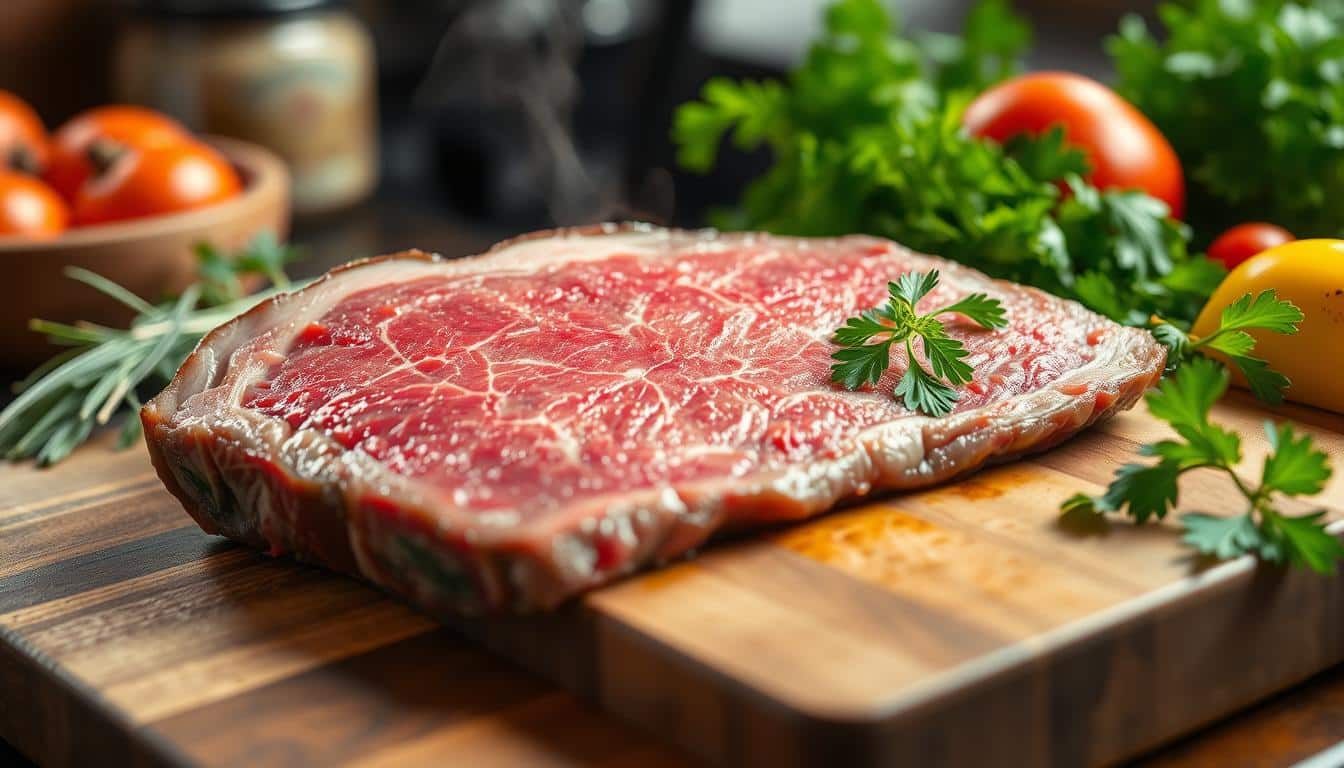A culinary revolution is happening in America. Japanese Wagyu steak, a top delicacy, is becoming more popular. It’s known for its soft texture and rich, buttery taste.
Now, you can enjoy authentic Wagyu in the US. It’s on the menus of fancy steakhouses and meat markets. No need to fly to Tokyo to taste it.
Japanese Wagyu steak is loved for its unmatched quality. Its special marbling makes it stand out. This fat makes the steak tender and juicy, unlike any other.
Understanding Japanese Wagyu Steak: A Culinary Marvel
Japanese Wagyu steak is a top choice for food lovers. It’s known for its amazing marbling and deep umami taste. This beef has won the hearts of many around the world, giving a special dining experience.For tips on grilling high-quality beef, check out our Perfectly Grilled Ribeye.
The History and Heritage of Wagyu Cattle
Wagyu, or “Japanese cow,” has a long history. These cows were first valued for their strength. Later, they were bred for better meat quality, leading to the marbled beef we enjoy today.
What Makes Wagyu Different from Regular Beef
Wagyu beef has more fat inside the meat. This fat makes it tender and tastes like butter. Wagyu cows are raised carefully, with special diets and stress-reduction to enhance their fat.
The Science Behind Wagyu’s Marbling
The magic of Wagyu’s marbling comes from its genetics and how it’s raised. Wagyu cows can store fat in their muscles, creating a unique marbling pattern. This fat melts easily, making the steak tender and juicy with a rich flavor.
| Characteristic | Wagyu Beef | Regular Beef |
|---|---|---|
| Marbling | Extensive | Moderate to Low |
| Flavor Profile | Rich Umami | Varies |
| Tenderness | Extremely High | Variable |
Understanding Japanese Wagyu helps us see its true value. It shows the skill and artistry in making this special beef.
The Different Grades of Japanese Wagyu
Japanese Wagyu is known for its high quality. Knowing the grading system helps buyers choose the best Premium Steak. Let’s look at the Beef Grades and what makes A5 Wagyu special.
Understanding the A5 to A1 Grading System
The Japanese Beef Marbling Standard (BMS) is the basis for Wagyu grading. This system rates beef from A5 to A1, with A5 being the highest. The number shows the yield grade, and the letter shows the meat quality.
| Grade | Marbling Score | Quality |
|---|---|---|
| A5 | 8-12 | Exceptional |
| A4 | 6-7 | Excellent |
| A3 | 4-5 | Good |
| A2 | 2-3 | Average |
| A1 | 1 | Poor |
Identifying Authentic Grade Certifications
Genuine A5 Wagyu comes with a certificate of authenticity. This document shows the cow’s lineage, farm, and slaughter date. Always ask for this certification when buying Wagyu to ensure it’s real.
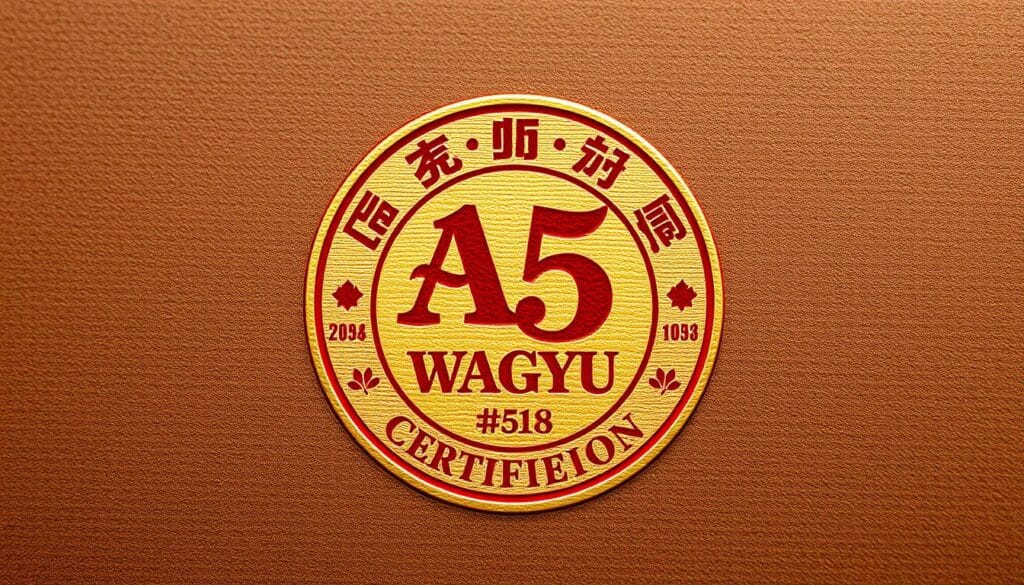
Price Points and Quality Markers
A5 Wagyu is expensive because of its unmatched marbling and flavor. It has a deep red color with white marbling. While prices vary, expect to pay a lot for this top-tier beef. True A5 Wagyu is worth it for its amazing taste and texture.
Where to Find Authentic Japanese Wagyu Steak in America
Finding real Japanese Wagyu Steak in America takes some effort. We’ve searched the country to find the top places for this special beef.
American Steakhouses now offer true Kobe Beef and other top Wagyu cuts. In New York, CUT by Wolfgang Puck has A5 Wagyu from Miyazaki Prefecture. Chicago’s RPM Steak has a changing selection of Japanese Wagyu, including rare Olive Wagyu.
If you like to cook at home, check out specialty meat markets. The Meat Hook in Brooklyn and Gwen Butcher Shop in Los Angeles sell real Japanese Wagyu. Online stores like Crowd Cow and Holy Grail Steak Co. also ship Wagyu right to your door.
| Location | Establishment | Wagyu Offerings |
|---|---|---|
| New York | CUT by Wolfgang Puck | A5 Miyazaki Wagyu |
| Chicago | RPM Steak | Rotating Japanese Wagyu Selection |
| Brooklyn | The Meat Hook | Various Japanese Wagyu Cuts |
| Los Angeles | Gwen Butcher Shop | Authentic Japanese Wagyu |
Always check the source and authenticity of Wagyu before buying. Look for certification from the Japan Meat Grading Association. This way, you’ll enjoy real Japanese Wagyu Steak soon.
Distinguished Japanese Cattle Breeds in American Markets
Japanese cattle breeds are now popular in America. They bring unique flavors and textures. We’ll look at the top breeds and their effect on U.S. beef.
Kuroge Washu (Japanese Black)
Kuroge Washu, or Japanese Black, is famous for top-notch beef. They have great marbling and tender meat. Ranchers in America use Japanese cattle raising techniques to raise this breed.
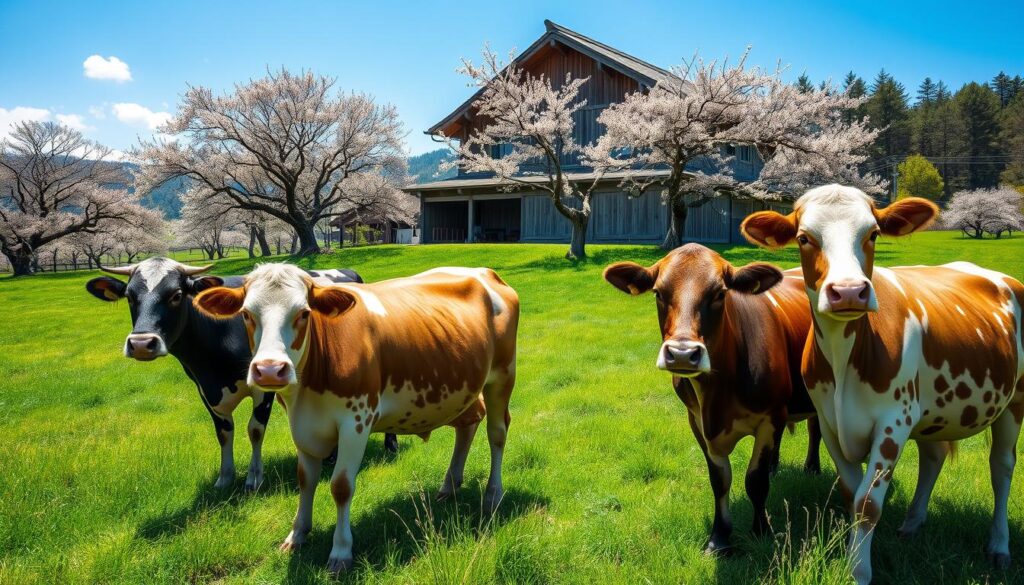
Tajima-Gyu Bloodline
The Tajima-Gyu bloodline is part of Kuroge Washu. It’s known for Kobe beef. This bloodline is prized for its rich flavor and marbling. Even though true Kobe beef is rare here, Tajima-Gyu genetics make American Wagyu premium.
American-Raised Japanese Wagyu
U.S. ranchers have bred Japanese Wagyu cattle. They mix Japanese genetics with American farming. This creates high-quality beef that’s easier for Americans to get. The meat has great marbling, but it might taste a bit different due to diet and environment.
| Breed | Origin | Key Characteristics |
|---|---|---|
| Kuroge Washu | Japan | Exceptional marbling, tender meat |
| Tajima-Gyu | Hyogo Prefecture, Japan | Intense marbling, rich flavor (Kobe beef) |
| American Wagyu | United States | Japanese genetics, American-raised, good marbling |
The Art of Preparing Premium Wagyu Steak
Learning to prepare Wagyu steak takes your cooking to the next level. We’ll show you the best ways to bring out its rich flavor.For a French-inspired steak dish, explore our Steak Diane Recipe.
Temperature and Timing Considerations
Make sure your Wagyu is at room temperature before cooking. This helps it cook evenly and keeps it tender. Let it sit for 30-60 minutes before cooking.
Seasoning and Cooking Methods
Seasoning Wagyu is simple. Just a little sea salt is enough to highlight its taste. Here are some cooking methods:
- Pan-searing: Quick and effective for a crispy crust
- Grilling: Ideal for thicker cuts, imparting a smoky flavor
- Sous-vide: Perfect for precise temperature control
Resting and Serving Techniques
After cooking, let your Wagyu rest for 5-10 minutes. This makes it juicy and full of flavor. Serve it sliced against the grain for extra tenderness.
| Cooking Method | Temperature | Time |
|---|---|---|
| Pan-searing | 425°F | 2-3 minutes per side |
| Grilling | 450°F | 3-4 minutes per side |
| Sous-vide | 129°F | 1-2 hours |
By using these techniques, you’ll make your Wagyu steak unforgettable. It will be a feast for your taste buds, full of umami flavor.
Comparing Japanese Wagyu to American Prime Beef
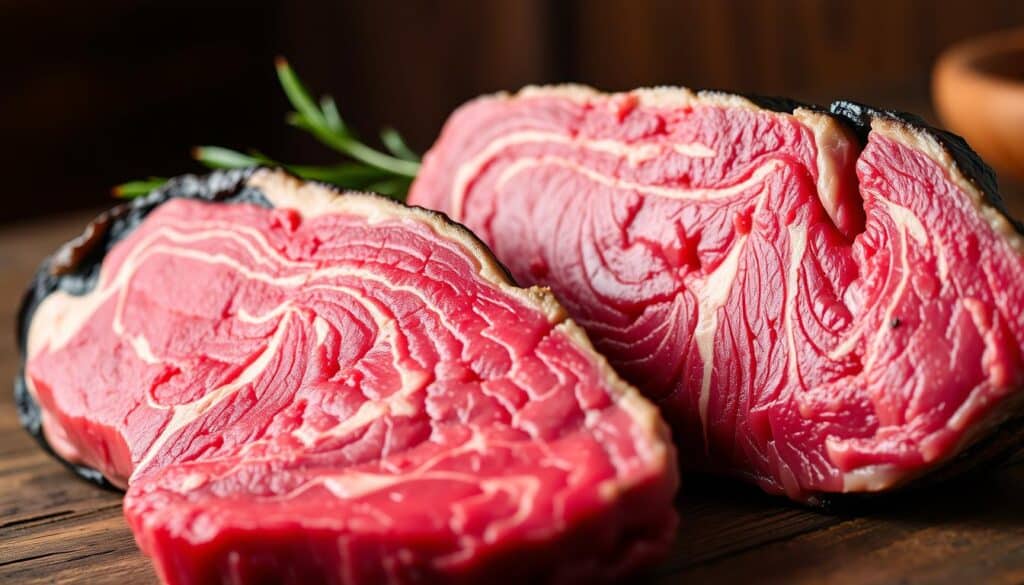
Japanese Wagyu and American Prime beef are top choices for premium steak. They are both high-quality but have big differences.
Japanese Wagyu is famous for its rich marbling. This makes it melt in your mouth. The fat in Japanese Wagyu creates a buttery taste. American Prime beef is also good but has less marbling and is firmer.
The beef grades in Japan and the U.S. show these differences:
| Characteristic | Japanese Wagyu | American Prime |
|---|---|---|
| Marbling Score | BMS 8-12 (A5 grade) | Modest to Slightly Abundant |
| Texture | Extremely tender | Tender |
| Flavor Profile | Rich, buttery | Beefy, robust |
| Fat Content | Higher (up to 50%) | Lower (10-15%) |
| Price Range | $100-$200+ per pound | $20-$50 per pound |
Both Japanese Wagyu and American Prime are great for steak lovers. But Wagyu’s special marbling and taste make it a luxury choice.
The True Cost of Authentic Wagyu: What to Expect
Japanese Wagyu Steak is very pricey. This is because it’s of top quality and rare. Let’s look at what makes it so expensive and why it’s worth it.
Retail Pricing Structure
In stores, A5 Wagyu can cost a lot. A pound of this steak might be $200 to $300. The price goes up because of special breeding, food, and limited making.
Restaurant Mark-ups and Value
Restaurants charge a lot more for Wagyu. A 4-ounce piece can be $100 to $250. This price includes the chef’s skill and the whole dining experience.
| Cut | Retail Price (per lb) | Restaurant Price (4 oz) |
|---|---|---|
| A5 Ribeye | $250-$300 | $150-$200 |
| A5 Tenderloin | $200-$250 | $125-$175 |
| A5 Striploin | $225-$275 | $140-$190 |
Investment in Quality
Buying Japanese Wagyu means you’re getting unmatched marbling, tenderness, and taste. The making process, like massages and beer for the cattle, adds to the cost. Yet, many steak lovers say the unique flavor is worth the price.
How to Identify Genuine Japanese Wagyu
Finding real Japanese Wagyu can be hard. We’ll show you how to make sure you get the real thing. True Wagyu comes from certain Japanese cattle and has official grades.
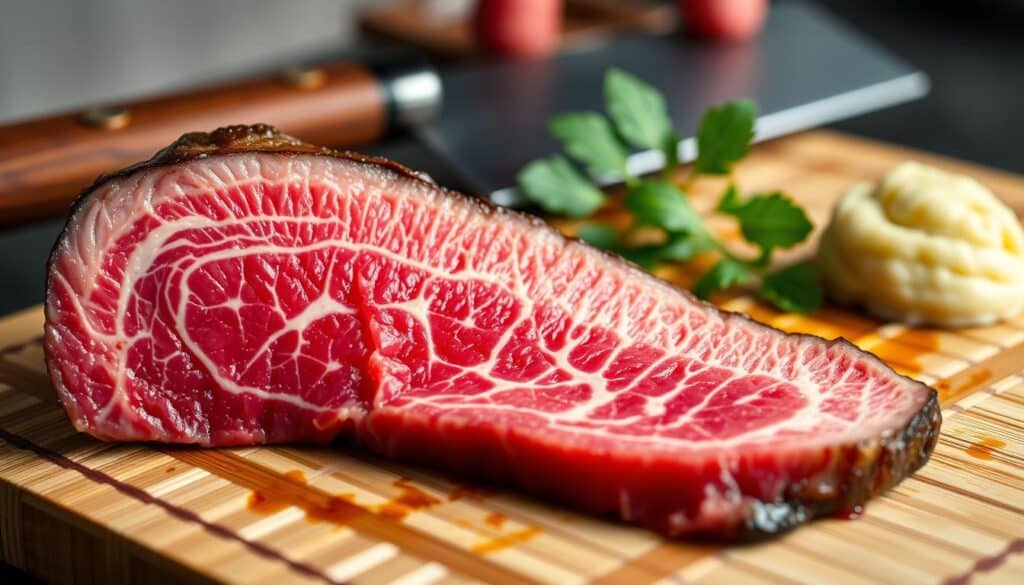
- Certificate of Authenticity
- 10-digit identification number
- Nose print of the cow
- Lineage information
Kobe Beef is famous Wagyu from Hyogo Prefecture in Japan. Watch out for places claiming to sell Kobe Beef without proof.
| Feature | Genuine Wagyu | Imitation |
|---|---|---|
| Marbling | Intense, snowflake-like pattern | Less pronounced, irregular |
| Color | Bright red meat, white fat | Darker red, yellowish fat |
| Texture | Soft, melts in your mouth | Tougher, chewier |
| Price | Higher, reflects quality | Significantly lower |
Real Japanese Wagyu is rare and pricey. If the cost is too low, it’s likely fake. Buy from trusted places and ask for proof.
Pairing and Serving Suggestions for Wagyu Steak
Enjoying Japanese Wagyu Steak is more than just the meat. We’ve found the best ways to make it even better. These tips will help you enjoy the Umami Flavor of this special beef.For dessert ideas to pair with your Wagyu, explore our Dessert & Juices Collection.
Wine and Beverage Recommendations
The marbling in Wagyu steak needs strong, tannic wines. A full-bodied Cabernet Sauvignon or a robust Syrah is perfect. For drinks without alcohol, try sparkling water with a bit of yuzu juice.
Complementary Side Dishes
Choosing the right sides can make Wagyu steak even better. Grilled asparagus, roasted mushrooms, or a light salad with citrus vinaigrette are great. Stay away from heavy sauces that hide the steak’s taste.
| Side Dish | Flavor Profile | Texture |
|---|---|---|
| Grilled Asparagus | Earthy, Slightly Bitter | Crisp-Tender |
| Roasted Mushrooms | Umami, Savory | Meaty, Chewy |
| Citrus Salad | Bright, Acidic | Crisp, Refreshing |
Portion Size Guidelines
Japanese Wagyu Steak is very rich. It’s best to eat it in small amounts. Aim for 3-4 ounces per person. This way, everyone can enjoy the unique flavors without feeling too full.
The main goal is to make a meal that shows off the Wagyu beef. With these tips, you’ll create a memorable dining experience.
Conclusion
Japanese Wagyu steak is a true culinary gem. It’s known for its rich marbling and unmatched flavor. This makes it a top choice in America.
We’ve looked into what makes authentic Wagyu special. It’s different from other beef options. The unique qualities are what make it stand out.
Learning about Wagyu’s grading system and cattle breeds is key. It shows the luxury of this meat. Preparing Wagyu steak requires skill to bring out its best.
Wagyu is becoming more popular in the U.S. It’s important to know how to spot real Japanese Wagyu. This guide aims to help you appreciate the craftsmanship of Wagyu steak.
Next time you want a great dining experience, try authentic Wagyu. You’ll enjoy its unique taste and texture.

